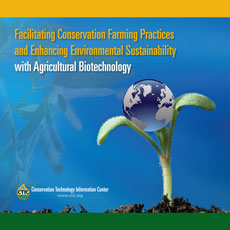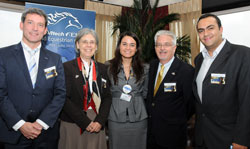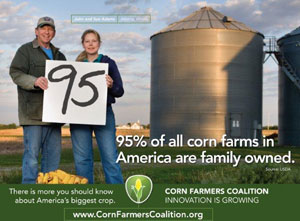Registration is now open for this year’s BlogWorld and New Media Expo. I attended last year and am hoping to do so again this year schedule permitting. If you really want to hone your new media and social networking skills then this is the place to do it. It would be cool to have other ag folks there!
Join us at the World’s Largest New Media event and learn about Content Creation, Distribution and Monetization strategies, step-by-step techniques and bleeding-edge tools from the most successful Bloggers, Podcasters, Social Media Pro’s, Internet TV and Radio Broadcasters, and Podcasters! From the premier educational sessions at the Social Media Business Summit and BlogWorld Conference, to the resource-rich New Media Expo, to Amazing Networking events…it’s One economical trip, One weekend, One Big Show you can’t afford to miss!

CTIC Releases Sustainability & Biotechnology Report
 The Conservation Technology Information Center has just released a new report dealing with the “S” word. That would be sustainability and it’s no surprise that agricultural biotechnology will play a key role in this issue as farmers work to feed a growing world population. You can find an executive summary here.
The Conservation Technology Information Center has just released a new report dealing with the “S” word. That would be sustainability and it’s no surprise that agricultural biotechnology will play a key role in this issue as farmers work to feed a growing world population. You can find an executive summary here.
Keeping agriculture environmentally sustainable while improving productivity is a growing challenge, and a new report shows that agricultural biotechnology is a key tool in overcoming it.
Biotech crops help growers around the world increase yields, improve crop quality and characteristics, and adopt sustainable farming practices such as conservation tillage — all vital to keeping up with the world’s growing demand for food, feed, fuel and fiber.
The booklet — “Facilitating Conservation Farming Practices and Enhancing Environmental Sustainability with Agricultural Biotechnology” — was developed by the Conservation Technology Information Center (CTIC) to dig deep into the data surrounding the adoption of biotech crops.
Read More
Southern States Partners With World Equestrian Games
 One of the global partners with Alltech for the upcoming World Equestrian Games is Southern States Cooperative, Inc.. Representing the company during the Alltech Symposium was F.E. Carter, pictured second from right. This was a group photo of the people I interviewed during a reception for the global partners.
One of the global partners with Alltech for the upcoming World Equestrian Games is Southern States Cooperative, Inc.. Representing the company during the Alltech Symposium was F.E. Carter, pictured second from right. This was a group photo of the people I interviewed during a reception for the global partners.
F.E. is a big fan of the Alltech Symposium and really appreciates sessions on topics like branding since that is something he says his company takes very seriously. He says that as a feed partner with Alltech in the upcoming games he looks forward to opportunities to promote their brand.
You can listen to my interview with F.E. below.
Talking Urban Gardening With Seedleaf
 During the Alltech Symposium the media had an opportunity to take an urban garden tour. I could not make it but I did meet the tour guide, Rebecca Self, Education Director for Seedleaf.
During the Alltech Symposium the media had an opportunity to take an urban garden tour. I could not make it but I did meet the tour guide, Rebecca Self, Education Director for Seedleaf.
The purpose of Seedleaf is to increase the amount, affordability, nutritional value, and sustainability of food available to people at risk of hunger in central Kentucky.
Rebecca says their goal is to nourish the community in Lexington and with an agricultural connection. She says they hope to be a bridge for urban people to understand where their food comes from. The urban garden tour was set up to showcase some of the downtown gardens they’ve helped foster.
She says the education information they provide covers all aspects of building, planting and caring for an urban garden. The organization is relatively new having started in 2008.
You can listen to my interview with Rebecca below.
Corn Farmers Coalition Unveils New Ad Campaign
Yes, Virginia, there really are family farmers.
 The Corn Farmers Coalition announced today they will return to Washington this summer with a major educational program aimed at policymakers and opinion leaders who affect the fate of America’s family corn farmers.
The Corn Farmers Coalition announced today they will return to Washington this summer with a major educational program aimed at policymakers and opinion leaders who affect the fate of America’s family corn farmers.
“The vast majority of farms in America, and 95 percent of corn farms specifically, continue to be family owned and operated ventures. They aren’t some myth, but are a critical economic engine that provides most of the food, feed and fiber produced in this country,” said Darrin Ihnen, president of the National Corn Growers Association. “This awareness is important to our survival.”
Corn farmers from 14 states and the National Corn Growers Association are supporting the Corn Farmers Coalition program to introduce a foundation of facts seen as essential to decision making, rather than directly influencing legislation and regulation.
“Our mission is to put a face on today’s family farmers, showcase the productivity and environmental advances being made in the industry, provide factual information on how innovative and high tech corn farmers have become,” said Ihnen. “This is a corn farmer image effort designed for thought leaders in Washington. When all the business news out there seems to be negative, corn farmers have a great story to tell.”
The Corn Farmers Coalition will launch a major advertising campaign June 1,that will put prominent facts about family farmers in Capital Hill publications, radio, frequently used web sites, the Metro and Reagan National Airport. The program, which puts a focus on family farmers telling their story, will continue until Congress recesses in August.
Among the corn farmer faces in the ads that will be popping up around DC are Kurt Hora and his family from Washington, Iowa and John & Sue Adams of Atlanta, Illinois (pictured). Listen to or download their comments from this morning’s press conference here:
Portugal Participation At Alltech FEI World Equestrian Games
 The Alltech FEI World Equestrian Games will have over 60 different countries represented and one of those is Portugal. I met Ingrid Van Dorpe, Premix, during last week’s Alltech Symposium. Her company is one of the global partners in the games.
The Alltech FEI World Equestrian Games will have over 60 different countries represented and one of those is Portugal. I met Ingrid Van Dorpe, Premix, during last week’s Alltech Symposium. Her company is one of the global partners in the games.
I asked Ingrid what she thought of this year’s Symposium first and she says it provides her with a glimpse of the future of animal nutrition. She takes home not only nutrition information but also other business information like branding and she feels more energized. Turning to the Games she says she expects to receive some good promotion for her business while bringing more attention internationally to the value and benefits of good nutrition for their animals.
You can listen to my interview with Ingrid below.
Animal Rights Activists Release Awful Video
This is a heads up in case you haven’t heard about it. Yesterday the Associated Press published a story about a video that was allegedly taken undercover at an Ohio dairy farm by the group Mercy For Animals. It is a shocking and disturbing video and whoever is actually involved should be put in jail for a very long time. If you click through and watch the video be warned. It’s graphic and bad.
Regardless of who is responsible for the violent acts in the video this will be used by animal rights activists to tarnish the image of good dairy farmers everywhere. This is a group of militant vegans with an agenda so it is good to question their credibility and motivation. We’ll do an update on the story when more information comes to light. You can get some perspective from a story by the ABN Radio Network which contains an interview with Joe Cornely, Ohio Farm Bureau. Michele Payn-Knoper has also offered some perspective on her blog.
Syngenta Donating To Weeding Out Hunger Via Halex GT Sales
 As Cindy has reported on earlier this year, Syngenta has started a program called Weeding Out Hunger. They just announced that a portion of their sales of Halex GT will be donated to the program.
As Cindy has reported on earlier this year, Syngenta has started a program called Weeding Out Hunger. They just announced that a portion of their sales of Halex GT will be donated to the program.
This season, growers can join the fight to weed out hunger by purchasing Halex® GT post-emergence corn herbicide for their glyphosate-tolerant corn acres. Through the Halex GT Weeding out Hunger™ campaign, a portion of 2010 herbicide sales will be donated to local Feeding America® food banks to help alleviate hunger in local communities across the Corn Belt.
“When growers purchase Halex GT in 2010 to treat their corn, they’ll be giving back to their neighbors in need,” said Carroll Moseley, herbicide brand manager for Syngenta Crop Protection. “We’re going to donate a portion of sales, up to $100,000, to Feeding America food banks in communities across the country and that gives growers another reason to choose Halex GT over the competitors.”
According to the USDA, more than 49 million Americans, one in six people, are food insecure, which means they do not have enough food to eat because of limited money or other resources. This startling statistic prompted Syngenta to develop the Weeding out Hunger campaign in conjunction with Halex GT.
You can follow the program on Twitter.
Zimfo Bytes
- The National Sustainable Agriculture Standards Committee will hold its third meeting in Fayetteville, Ark., on June 14 and 15, 2010.
- Bayer CropScience Canada has officially retained M2 Universal, one of Canada’s largest media services companies. M2 Universal assumes all media planning (online & off-line) and purchasing responsibilities for Bayer CropScience Inc., Canada.
- The RISE President Search Committee is pleased to announce Aaron Hobbs has been selected as the President-Elect of RISE, effective June 1st.
- Ken Dalenberg, a Mansfield, Ill., corn and soybean farmer, is the 2010 Farmer Award winner in the PrecisionAg Awards Of Excellence program sponsored by The PrecisionAg Institute.

NCBA Answers Questions About New Governance Proposal
A proposal to restructure the nation’s largest beef cattle organization is generating some controversy.
 Representatives of the National Cattlemen’s Beef Association (NCBA) and the Federation of State Beef Councils met with USDA officials today to discuss NCBA’s proposed governance structure and held a conference with reporters afterward to review the outcome of the meeting.
Representatives of the National Cattlemen’s Beef Association (NCBA) and the Federation of State Beef Councils met with USDA officials today to discuss NCBA’s proposed governance structure and held a conference with reporters afterward to review the outcome of the meeting.
U.S. Agriculture Secretary Tom Vilsack sent a letter last week to Illinois cattle producer and NCBA President Steve Foglesong expressing the need for additional clarity regarding the proposed governance structure. “The effort NCBA has undertaken to change our governance structure has received an awful lot of attention, more than I thought we would going into this,” said Foglesong. “I’m going to take that as a compliment – people really do care about NCBA and what we do.”
Steve says NCBA’s goals are to fuel producer profitability by building and protecting beef demand and to preserve producers freedom to operate without excessive government intervention. “I believe our proposed governance model helps deliver on these goals by increasing producer input into our programs and policies and by enabling quicker decision making through a 29 member board, rather than our current 274 member board.”
Vilsack expressed concern that the proposed structure would “weaken the firewall between policy and checkoff funded activities, thereby jeopardizing the Beef Checkoff program and set a bad precedent for checkoff programs in general.” Foglesong and Scott George, NCBA Federation Division Chair and Wyoming dairy/beef producer addressed each of Vilsack’s concerns one at a time in answer to questions from reporters.
“The problem we’re having here is a break down in understanding what ‘firewall’ is,” said George. “We believe the firewall is an accounting firewall and that has been strictly enforced and will continue to be strictly enforced.”
Foglesong stressed their transparency throughout the restructuring process. “This is a draft,” Foglesong said. “That’s one of the reasons that it passed by 94 percent at the convention. We made changes and we listened to people.”
Industry representatives will be meeting with other groups who have concerns about the restructuring this week.
Listen to or download the entire press conference here:

